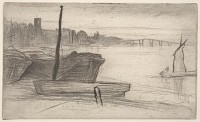Chelsea Bridge and Church | ||
| Number: | 102 | |
| Date: | 1871 | |
| Medium: | etching and drypoint | |
| Size: | 103 x 170 mm | |
| Signed: | no | |
| Inscribed: | no | |
| Set/Publication: | 'Thames Set', 1871 | |
| No. of States: | 7 | |
| Known impressions: | 56 | |
| Catalogues: | K.95; M.96; T.53; W.85 | |
| Impressions taken from this plate (56) | ||
PUBLICATION
Chelsea Bridge and Church was published in A Series of Sixteen Etchings of Scenes on the Thames (the 'Thames Set'), by Ellis & Green in 1871.
A review of the set commented: 'No. 15 is an opal-like study of a hazy effect, derived from a locality which the etcher has illustrated on different occasions in a charming manner.' 14
14: [F.G. Stephens], The Athenaeum, 26 August 1871, pp. 280-81.
EXHIBITIONS
Since it had been published, this was comparatively well known. It was exhibited in Philadelphia in 1879 and at the Union League Club in New York, lent by Samuel Putnam Avery (1822-1904) (, and or possibly ). 15
It was shown at several print dealers' shows, by Craibe Angus in Glasgow in 1879, in New York by F. Keppel & Co. in 1902 and by H. Wunderlich & Co. in 1898 () and 1903, and in London by Obach & Co. in 1903. Charles Lang Freer (1856-1919) bought an impression from the 1898 show (). 16
An impression hung in an major exhibition in Leipzig in 1895. Another was shown in the exhibition organised by the Caxton Club in Chicago in 1900, lent by Bryan Lathrop (1844-1916) (). 17
It was shown at several print dealers' shows, by Craibe Angus in Glasgow in 1879, in New York by F. Keppel & Co. in 1902 and by H. Wunderlich & Co. in 1898 () and 1903, and in London by Obach & Co. in 1903. Charles Lang Freer (1856-1919) bought an impression from the 1898 show (). 16
An impression hung in an major exhibition in Leipzig in 1895. Another was shown in the exhibition organised by the Caxton Club in Chicago in 1900, lent by Bryan Lathrop (1844-1916) (). 17
15: New York 1881 (cat. no. 119, 120). See REFERENCES : EXHIBITIONS.
16: New York 1898 (cat. no. 80).
17: Chicago 1900 (cat. no. 80).
After Whistler's death in 1903, an impression was shown at the comprehensive exhibition at the Grolier Club, New York, 1904, and another in the Whistler Memorial show in London in 1905 (lent by King Edward VII). 18
18: New York 1904a (cat. no. 88); London Mem. 1905 (cat. no. 85).
SALES & COLLECTORS
In early days this etching was usually sold with complete 'Thames Sets'. A complete set was bought by South Kensington Museum (now the V&A) from Ellis & Green on 28 May 1871 for £12.12.0 the set, including Chelsea Bridge and Church (). It was a third state, and had been taken from Whistler's stocks of earlier impressions, preceding the main print-run of the 'Thames Set' in the fifth and sixth states.
The British Museum bought a final state in 1874 (); the Bibliothèque nationale de France bought two, one a cancelled impression, probably from Frederick Keppel (1845-1912) of F. Keppel & Co., in 1903 (, ); Henry F. Sewall (1816-1896) bought one for the Boston Museum of Fine Arts in 1897 ().
The British Museum bought a final state in 1874 (); the Bibliothèque nationale de France bought two, one a cancelled impression, probably from Frederick Keppel (1845-1912) of F. Keppel & Co., in 1903 (, ); Henry F. Sewall (1816-1896) bought one for the Boston Museum of Fine Arts in 1897 ().
A few unusual impressions fetched good prices. For instance a 'trial proof, the first taken from the plate', from the collection of the late Joshua Hutchinson Hutchinson (ca 1829 - d.1891), was bought by Deprez & Gutekunst in 1892 for £2.7.6. 19 However, except for unusual impressions, prices could be very low; and Keppel paid only £0.2.0 for an impression in 1893. 20
19: Sotheby's, 3 March 1892 (lot 136).
20: Christie's, 14 March 1893 (lot 315).
An impression owned by Francis Seymour Haden, Sr (1818-1910) was sold in 1898 through H. Wunderlich & Co. to Charles Lang Freer (1856-1919) (). Freer bought a 'darkly printed' final state from F. Keppel & Co. in 1894 () and a lighter one from Thomas Way (1837-1915) in 1905 (); as well as an impression from the cancelled plate from Keppel in 1896 (). Similarly, Samuel Putnam Avery (1822-1904) bought an early state (), a later one with crayon additions (), and a final state ().
Other early collectors included James Smith (1831-1923) (); James Guthrie Orchar (1825-1888) (); George Aloysius Lucas (1824-1909) (); Bernard Buchanan MacGeorge (1845?-1924) and Howard Mansfield (1849-1938) (); Henry Studdy Theobald (1847-1934) (); Constantine Alexander Ionides (1833-1900), who bequeathed one in 1901 to the V&A (); Joseph Longworth, who gave an impression of the sixth state to Cincinnati Art Museum in 1883 (); Bryan Lathrop (1844-1916) () and Charles Deering (1852-1927) (), whose collections went to the Art Institute of Chicago; Henry Nazeby Harrington (1862-1937) (, ); Harry Brisbane Dick (1855-1916) (); and Pauline Kohlsaat Palmer (1882-1956) (). An impression acquired in 1893 by the Staatliche Graphische Sammlung, Munich, 1893 was destroyed in fire in 1944.
